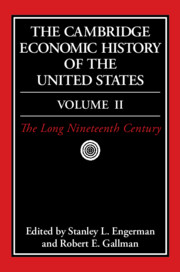Book contents
- Frontmatter
- 1 Economic Growth and Structural Change in the Long Nineteenth Century
- 2 The Economy of Canada in the Nineteenth Century
- 3 Inequality in the Nineteenth Century
- 4 The Population of the United States, 1790–1920
- 5 The Labor Force in the Nineteenth Century
- 6 The Farm, The Farmer, and The Market
- 7 Northern Agriculture and the Westward Movement
- 8 Slavery and its Consequences for the South in the Nineteenth Century
- 9 Technology and Industrialization, 1790–1914
- 10 Entrepreneurship, Business Organization, and Economic Concentration
- 11 Business Law and American Economic History
- 12 Experimental Federalism: the Economics of American Government, 1789–1914
- 13 Internal Transportation in the Nineteenth and Early Twentieth Centuries
- 14 Banking and Finance, 1789–1914
- 15 U.S. Foreign Trade and the Balance of Payments, 1800–1913
- 16 International Capital Movements, Domestic Capital Markets, and American Economic Growth, 1820–1914
- 17 The Social Implications of U.S. Economic Development
- Bibliographic Essays
- Index
- References
14 - Banking and Finance, 1789–1914
Published online by Cambridge University Press: 28 March 2008
- Frontmatter
- 1 Economic Growth and Structural Change in the Long Nineteenth Century
- 2 The Economy of Canada in the Nineteenth Century
- 3 Inequality in the Nineteenth Century
- 4 The Population of the United States, 1790–1920
- 5 The Labor Force in the Nineteenth Century
- 6 The Farm, The Farmer, and The Market
- 7 Northern Agriculture and the Westward Movement
- 8 Slavery and its Consequences for the South in the Nineteenth Century
- 9 Technology and Industrialization, 1790–1914
- 10 Entrepreneurship, Business Organization, and Economic Concentration
- 11 Business Law and American Economic History
- 12 Experimental Federalism: the Economics of American Government, 1789–1914
- 13 Internal Transportation in the Nineteenth and Early Twentieth Centuries
- 14 Banking and Finance, 1789–1914
- 15 U.S. Foreign Trade and the Balance of Payments, 1800–1913
- 16 International Capital Movements, Domestic Capital Markets, and American Economic Growth, 1820–1914
- 17 The Social Implications of U.S. Economic Development
- Bibliographic Essays
- Index
- References
Summary
At the beginning of the nineteenth century a substantial proportion of monetary transactions in the United States were conducted with specie (gold or silver coins), in particular the Spanish peso. Merchants used bills of exchange and other financial instruments, and several private banks and the First Bank of the United States had been established, but commercial banking was in its infancy. By 1914 the United States had become one of the world’s leading financial powers; it possessed a well-developed banking system and a broad array of non-bank financial intermediaries. Watching over all stood the newly created Federal Reserve System. The development of the financial system in the interim had followed an erratic path. Wars, financial crises, changes in governments, changes in ideologies, and chance events often had produced substantial changes in the financial order in short periods of time. And it had been an unpredictable path. Often a very different path might have been followed were it not for the arguments laid out by a single individual or a single vote cast on an important bill. There was a tendency, moreover, to pass legislation that would have prevented the last crisis, only to discover that the next crisis presented entirely new features. Politicians, like generals, tended to fight the last war. Only by immersing oneself in the actual course of American financial history can one understand how the financial system evolved from its colonial roots to the complex system of specialized financial institutions that existed on the eve of World War I.
- Type
- Chapter
- Information
- The Cambridge Economic History of the United States , pp. 643 - 684Publisher: Cambridge University PressPrint publication year: 2000
References
- 10
- Cited by



